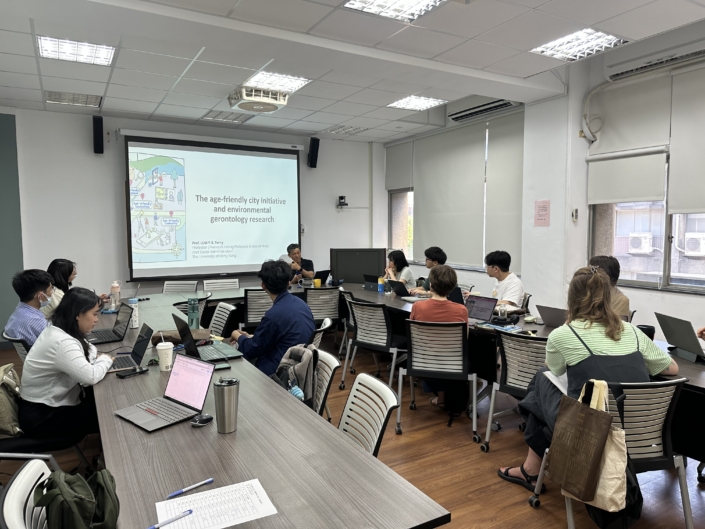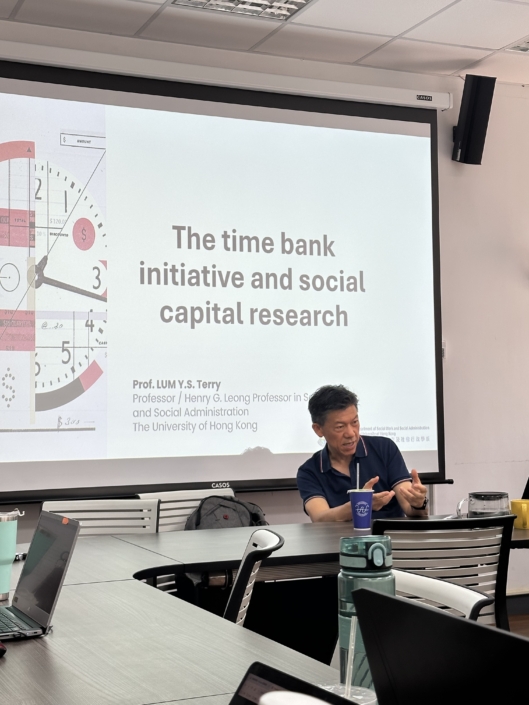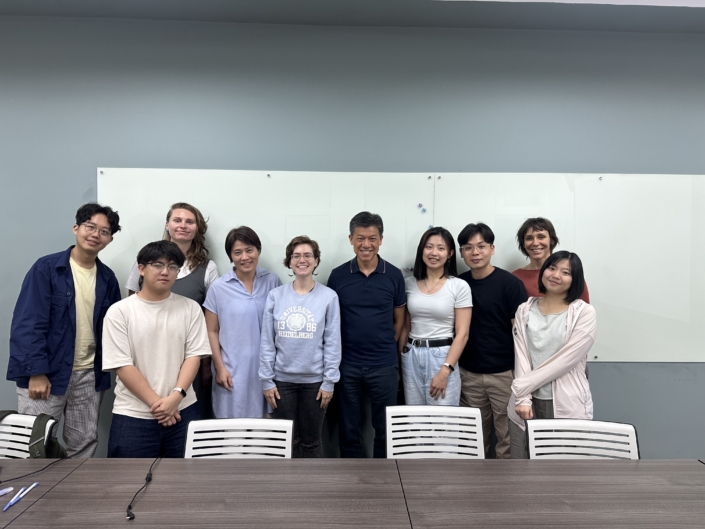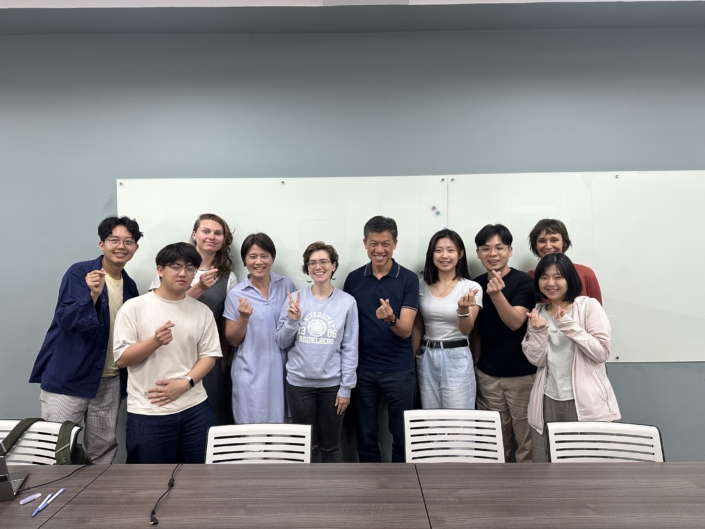Social Innovations to Prepare Hong Kong for the Rapid Population Aging
2025.05.02
How Should Cities Respond to Population Ageing? — Professor Terry Yat Sang Lum from the University of Hong Kong Shares Insights on the Age-Friendly City Initiative and Environmental Gerontology
As population ageing becomes a global trend, one of the most pressing challenges for governments and societies is how to design cities where older adults can live safely, healthily, and independently. Professor Terry Yat-Sang Lum shared his extensive research and practical experience in the fields of the Age-Friendly City Initiative and Environmental Gerontology, guiding students to examine how cities can respond to the needs of super-aged societies through thoughtful environmental and community planning.
Global Ageing and the Age-Friendly Cities Initiative
According to WHO statistics, by 2025, the number of people aged 60 and above will reach one billion, with more than 80% living in low- and middle-income countries. Professor Lum emphasized that modern society has long been designed primarily around the needs of the young—whether in infrastructure, transportation, or policy-making—and that cities must now undergo a structural transformation to address the needs of older adults.
Since 2005, the World Health Organization (WHO) has promoted the Age-Friendly Cities (AFC) framework, which proposes eight key domains for building inclusive cities: transportation, housing, outdoor spaces, social participation, civic participation and employment, respect and social inclusion, communication and information, and community support and health services. The initiative calls for environmental changes and cultural shifts to create communities that are friendly for all ages.
The Hong Kong Experience: Community-Academic Partnerships for Local Transformation
In class, Professor Lum introduced The Hong Kong Jockey Club Age-Friendly City Project as a model of cross-sector collaboration, involving universities, NGOs, local governments, and community groups. The project carried out baseline assessments, developed district-level action plans, trained “AFC ambassadors,” and launched local age-friendly initiatives. Covering 18 administrative districts and offering annual funding to support community efforts, the project has directly benefited over 110,000 individuals and earned recognition from the WHO Global Network for Age-Friendly Cities and Communities.
More than a physical transformation, Professor Lum emphasized the project’s role in promoting positive views on ageing, increasing older adults’ engagement in public affairs, and enhancing community sensitivity and responsiveness to ageing-related issues.
Environmental Gerontology: Designing Cities that Respond to Psychosocial Change
Professor Lum also presented research conducted by his team in the field of environmental gerontology, exploring how urban design impacts older adults’ well-being. Key findings include links between access to green spaces and lower depressive symptoms, walkability and reduced dementia risk, facility density and cognitive function, and social participation’s impact on psychological well-being.
The studies suggest that well-designed built environments can delay physical and cognitive decline, support ageing in place, relieve caregiver burdens, and even shorten the period between functional impairment and end-of-life.
Through policy advocacy, community collaboration, and empirical research, cities can undergo structural reform to better meet the needs of their ageing populations and support longer, healthier lives.
2025.05.03
As societies around the world move toward population ageing, how can social innovation respond to the complex challenges that come with it? In this intensive course, Professor Terry Lum shared his extensive theoretical, policy, and practical experience through two thematic lectures: “The Time Bank Initiative and Social Capital Research” and “Cognitive Stimulation Therapy and Project BrainLive”. The sessions provided students with valuable interdisciplinary insights into age-friendly practices and innovations.
Morning Session|The Time Bank Initiative and Social Capital Research
The morning session began with a discussion on the concept of social capital, drawing on the foundational work of Bourdieu, Coleman, and Putnam. Professor Lum explored how interpersonal networks form the basis of support systems that promote mutual aid and healthy ageing in communities. He emphasized that social capital goes beyond relationships to include elements such as trust, norms, network structures, and resource flows—further categorized into bonding, bridging, linking, structural, cognitive, and relational dimensions.
Professor Lum then introduced the Time Bank model, developed by Edgar Cahn. Based on the principle of mutual exchange—”one hour of service equals one time credit”—the system redefines the value of volunteering and community participation. Regardless of background or profession, participants accumulate time credits through service and can redeem them for other forms of support.
Using Hong Kong’s “Weaving a Better Life” project as a case study, Professor Lum illustrated how older adults earn time credits through services like medical escort, home visits, or basic repair work. Supported by the HINCare App and AI technology for service matching and record-keeping, the initiative enhances older adults’ participation and strengthens community cohesion and resource flow.
Research findings confirm that the time bank model contributes to improved health, a stronger sense of self-worth, and enhanced belonging—especially for marginalized groups. As Professor Lum noted, “Older adults should not be seen as passive recipients of care, but as capable social assets who deserve recognition and connection.”
Afternoon Session|Cognitive Stimulation Therapy and Project BrainLive: A Task-shifting Approach to Dementia Support in Hong Kong
The afternoon session shifted focus to non-pharmacological interventions for dementia care, spotlighting Cognitive Stimulation Therapy (CST) and Project BrainLive, an online service model developed in response to the COVID-19 pandemic.
Rooted in the biopsychosocial model, CST involves theme-based group sessions (e.g., reminiscence, categorization, daily topics) to enhance participants’ language skills, memory, and social interaction. Evidence-based research has shown that CST significantly improves cognitive function and, in many cases, has comparable outcomes to pharmacological treatments in enhancing quality of life.
Project BrainLive was launched in Hong Kong during the pandemic as a digital innovation to ensure service continuity. Trained senior volunteers led online CST sessions and provided caregiver support. Research suggests that this model is not only feasible and cost-effective but also helps reduce social isolation among people with dementia, while strengthening family and community bonds.
Professor Lum also shared experiences in culturally adapting CST for Hong Kong, including adjusting session content for older adults with limited literacy and exploring the feasibility of volunteer-led interventions. These adaptations demonstrate how combining social capital and technology can bring flexibility and innovation to care models—especially in resource-constrained settings.
Reflection|Co-creating a Win-Win Society through Trust and Collaboration
Professor Lum concluded with a powerful analogy: “Academics are not just providers of knowledge—we are like chefs who turn diverse community ingredients into meaningful outcomes.” He emphasized that the key to building a healthy ageing society lies not in isolated interventions or policies, but in mutual trust and collaboration among academia, social service sectors, communities, and governments. Only through inclusive participation and cross-sector dialogue can we co-create an age-friendly society that is both resilient and truly inclusive.
Note taken by Chia-Chia Hsu






